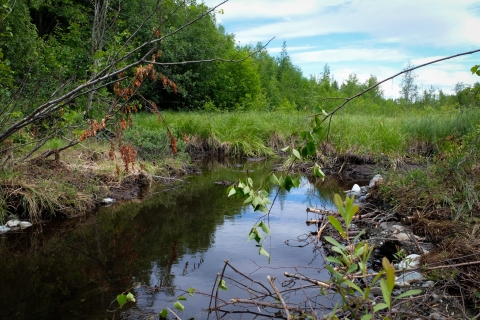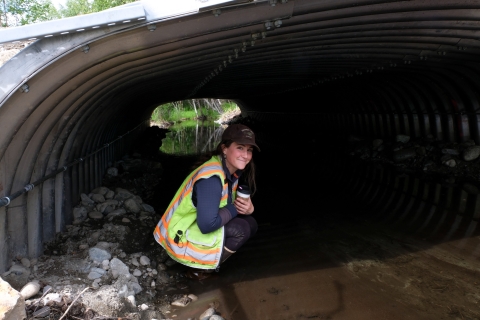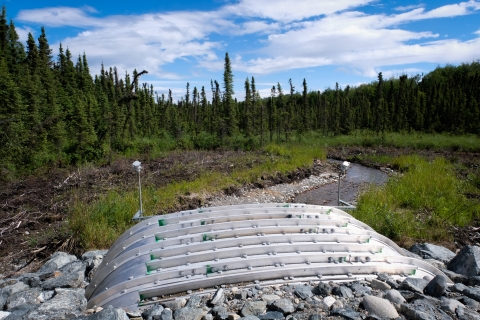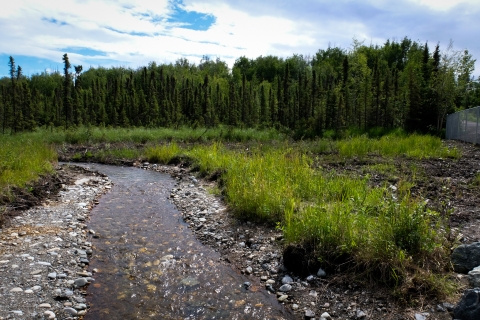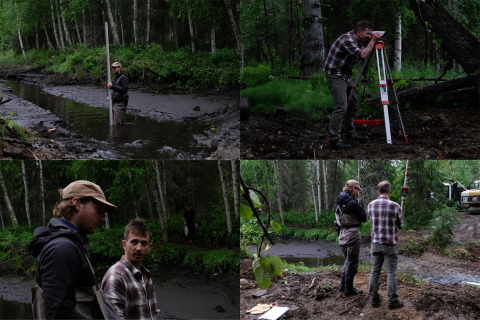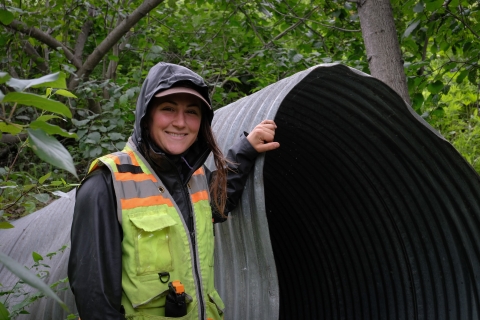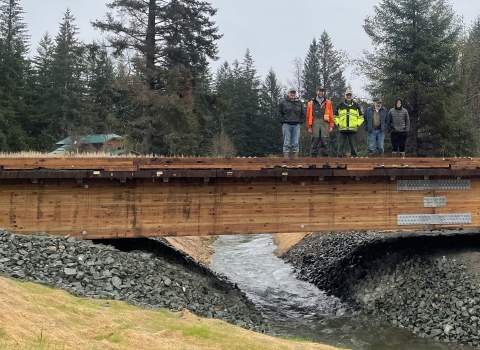Definition of riparian habitat or riparian areas.
Learn more about riparian habitat. July 3, 2023. Christian Thorsberg/USFWS.
Under a clear blue sky that would soon brim with fireworks — the Independence Day eve feeling like a warm, sunny embrace — Jess Straub brought a muddied pickup truck to rest along the banks of O’Brien Creek, where she hoped to soon see a different type of colorful explosion: The ruby-red backs of many adult coho salmon, migrating upstream.
But as Straub tucked her pantlegs into her boots and stepped along the channel's edge, there was only clear water and brownish yearlings before her.
The nine-mile O'Brien Creek, which flows through Wasilla before connecting with the Knik Arm in the Mat-Su Valley, is a “coho factory,” says Straub, a civil engineer with the Southern Alaska Fish and Wildlife Field Office’s Habitat Restoration Branch. The marshy, low gradient creek, she says, is exactly the type of habitat young coho frequently gravitate towards.
As if to punctuate the point, we see a handful pop into view and swim by — just a few of the thousands of juvenile salmonids who call the creek home today.
But there is one persisting quandary about these waters, which seems to contradict everything USFWS fish biologists know about the salmon’s life cycle: Despite the longstanding abundance of juveniles – including upstream of multiple culverts – not a single adult coho has been identified by the U.S. Fish and Wildlife Service in O'Brien Creek.
“It’s been a little bit of a mystery,” says Straub.
A Coho Life
The coho life span is similar to those of the other four Pacific Salmon species: they start life in freshwater, migrate to sea to grow large, and return to spawn and ultimately die.
In early spring, newborns hatch from their eggs and nestle into gravel beds at the bottom of freshwater creeks and streams, where they remain as alevin until they are strong enough to swim. Compared to other salmon species, coho tend to stay longer and use more of the watershed. Then, when they are anywhere from around 16 months to 4 years old, they migrate downstream and undergo significant physiological changes to survive in the saltier waters of estuaries and oceans (only around one percent of fish can do this).
Coho spend between 16 and 18 months growing in the ocean before returning to the fresh waters where they were born to spawn. Like all Pacific salmon, they then die shortly thereafter, giving themselves as nutrients to the habitat for the next generation’s benefit.
The Kids Are Alright
With their life cycle in mind, seeing only young coho — and no adults — in O’Brien Creek has continued to puzzle staff.
“It’s a really curious thing,” says Straub. “How are juveniles spread throughout the entire O’Brien Creek system, but the creek hasn’t been catalogued for adults?”
A few hypotheses have been percolating amongst the Southern Alaska Fish and Wildlife Field Office staff. The most outrageous? That the juveniles are being born in a different creek or stream, then entering the Knik Arm of Cook Inlet, before swimming up into O’Brien Creek. The most likely? That the adults are spawning near the mouth of the creek, where marine and freshwater meet, refraining from migrating upstream.
Welcoming Home Coho
If the most likely explanation is indeed the true one — that adult coho weren’t traveling up O’Brien Creek because its conditions were poor — U.S. Fish and Wildlife Service engineers hope that their efforts over the past five years will simultaneously benefit the overall ecosystem’s health, and sleuth out this mystery’s explanation.
Beginning in 2018 with data collection, project planning in 2019 and 2020, and preparing for construction in 2021 — working with state, nonprofit, and private landowner partners all the while — Straub and other engineers, hydrologists, and biologists designed four unique projects where roads or paths intersect with the creek: Rubacaba, O’Grady, Royal Lane, and Ervin.
Each has been completed in the past year with the goal of welcoming adult coho home.
Across the four projects, contracted crews installed wider culverts, or, at a site downstream, simply removed old ones that were too small for adult fish to swim through. Juveniles are found upstream all four culverts.
Following the team’s designs, crews also adjusted the creek’s slope and width in certain sections – upstream, downstream, and in the new culvert – to create more sustainable flow rates (how fast the water moves) and stabilize the channel. In the event of historic high- or low-flows, according to Straub, there will still be a path for fish to swim. “Being ‘stably dynamic’ is how we like to say it,” she says.
Nature-based designs were used to improve the health of the channel. Along the creek’s banks, beds of vegetation (called “veg mats”) were installed atop a crisscrossed tree limb matrix (called toewood) to help prevent erosion. And careful analysis of representative potential spawning ground in O’Brien Creek helped the team create the right mixture of sediment — size, material, texture — to place within the streambed itself.
“Sediment transport and movement are key functions of rivers and streams,” Straub says. “With fish passage fish passage
Fish passage is the ability of fish or other aquatic species to move freely throughout their life to find food, reproduce, and complete their natural migration cycles. Millions of barriers to fish passage across the country are fragmenting habitat and leading to species declines. The U.S. Fish and Wildlife Service's National Fish Passage Program is working to reconnect watersheds to benefit both wildlife and people.
Learn more about fish passage , you want to give the crossing adequate conveyance and enough time for the streambed to stabilize. Because, at the end of the day, we want the channel to create what it wants and needs when the project has been completed and is stable.”
A Team Effort
Now that all the projects are finished, there is hope that the O’Brien Creek mystery will be solved, and adult coho, if they want to, will have healthier waters in which to migrate. It could be as soon as the late summer or fall that the first appear.
At the very least, their offspring will have as many options as possible to contribute to the Cook Inlet waters.
All said, says Straub, reflecting on these four projects, the work was amplified by the collaboration of multiple minds: biologists, hydrologists, engineers, and others with land and waters expertise.
“When we're all together, we're providing a more holistic voice to the stream, letting it represent itself,” she says. “Having this interdisciplinary team that can really speak to the river, and what it wants to do — I love it. I know we can rely on them.”
Learn more about Jess Straub and other team members


